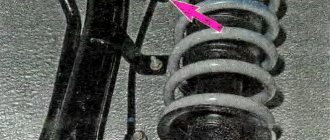To extend the life of the car body, you need to regularly monitor the condition of the drainage holes, otherwise rust may appear in the internal cavities. Also, do not forget to lubricate the rubbing parts of the body. Let's consider the features of such a service.
For LADA cars (XRAY, Vesta, Largus, Granta, Kalina, Priora, Lada 4×4) there are no fundamental differences in cleaning the drainage holes and lubrication of body fittings.
How to properly install drainage?
First, let's find out why drainage is needed. It helps excess moisture leave the soil so that it does not become acidic and the roots do not rot, that is, it serves as a natural drainage system.
To choose the right drainage, you should take into account the type of plant, size and material of the container . Before laying, you should choose the right drainage composition and find out how thick the layer should be.
Layer height
When calculating the height of the drainage layer, we focus on the shape and size of the pot:
- for a tall cone-shaped one - 4–6 cm;
- for wide and low - 1.5–2 cm;
- standard pot with the same dimensions of neck diameter and height - 3 cm.
The given values are used to fill medium-sized containers. If the parameters of the pot are significantly higher or lower than average, the drainage height should be:
- for narrow and tall containers - ¼ of the total volume;
- for wide and low ones - 1/8 of the volume;
- for standard ones - 1/5 of the volume.
How to change coolant
You will need: remove the crankcase protection (if necessary), a 13 mm spanner, a screwdriver, a clean wiping cloth, an empty container, and new antifreeze. Before draining the antifreeze from the Granta, you should first wait until the engine cools down, then:
- Remove the cap from the expansion tank.
- Place an empty container under the engine and remove the drain plug on the cylinder block.
- For VAZ-11183, VAZ-21116 and VAZ-11186 engines, to access the drain plug, you may have to remove the ignition coil along with the bracket.
- Wait until the antifreeze has completely drained.
- Place a container under the engine radiator and remove the drain plug on the radiator.
- Wait until the coolant has completely drained from the cooling system.
- Screw in the drain plug on the radiator, replacing the rubber O-ring if necessary.
- Tighten the plug on the cylinder block.
We pour new antifreeze into the Granta cooling system until its level reaches 25-30mm. below the “MAX” mark on the wall of the expansion tank. Then tighten the tank cap. Start the engine and let it warm up to operating temperature (before turning on the fan). Then turn off the engine and, if necessary, add fluid to the “MAX” mark. Check the fluid level after a few days. After replacing the antifreeze, monitor the coolant temperature in the instrument cluster.
If the overheating indicator lights up (No. 7) and the radiator fan does not turn on, turn on the heater (stove) and check what kind of air is coming from the air ducts. If the air is hot, there may be a malfunction in the fan operating system; if it is cold, it means that an air lock has formed in the cooling system.
What materials are suitable for arranging drainage?
Natural and artificial solid materials that are resistant to moisture can be used as drainage . Expanded clay, gravel and vermiculite are most often used, but there are also unexpected solutions.
Let's look at the characteristics of each to understand which drainage is better.
Crushed stone, pebbles and gravel
Common pasture material that is easy to obtain yourself. All three types pass water well, but, perhaps, this is their only advantage.
If we talk about the disadvantages, then we include the weight of the materials: when using them in large containers, it will be difficult to lift such a pot .
Attention! However, being overweight is not always a bad thing.
Heavy drainage will give plastic containers stability. All these materials conduct heat well, so they are not recommended for use for flowers overwintering on window sills . The pebbles will absorb the cold, which will negatively affect the roots of the plant, and it may get sick.
Vermiculite and perlite
Ready-made materials that are sold in packaged form in flower shops. Initially, it is an additive to the soil, which prevents its acidification and mold formation, but can also be used as a separate material for drainage . Other characteristics:
- have low thermal conductivity;
- sterile;
- They pass water well.
If they have a drawback, it is their high cost.
Expanded clay
Refers to popular types of drainage. It was originally created as insulation in the construction field. Made from foamed and fired clay. It varies in fraction sizes (fractions of 5–20 mm are suitable for drainage).
Expanded clay absorbs moisture and, when necessary, releases it . Added to the substrate, it maintains normal water balance in the soil. The advantages of the material include:
- light weight;
- affordable price;
- long (up to 5 years) service life.
Sold in construction and flower shops.
Attention! There is an opinion that expanded clay affects the acid-base balance of the substrate and can provoke diseases in the plant.
Expanded clay is sold in flower shops, the packaging of which states that it is enriched with microelements. It is difficult to verify how true this is. Let's wait for feedback from those who have used it.
Broken brick
If you have the opportunity to collect broken red brick, it will perfectly serve as drainage . This brick is made from clay, which means it has properties similar to expanded clay.
Ceramic shards
By collecting fragments of broken ceramic pots, dishes and other items, you can stock up on drainage. They are light in weight, have good drainage properties, do not absorb moisture, and do not contain chemicals .
The main thing is to be careful when collecting and laying them: do it with gloves so as not to get hurt by sharp chips.
Styrofoam
An easily accessible material that can be found in packaging for household appliances and after insulating walls during construction or renovation.
Foam plastic is a synthetic material obtained by foaming plastic. However, it is absolutely safe for plants , since it is sterile and resistant to infection by fungus and other harmful microorganisms.
Foam drainage does not absorb moisture, but does not release it either . If you want to improve its moisture transfer properties, you can mix pieces of foam with hydrogel.
As for the disadvantages, it is worth mentioning that plant roots can freely grow into the foam, which will create difficulties when replanting them .
In addition, the material weighs almost nothing. It is not suitable for plastic containers, but it is ideal for large ceramic pots, since it will not add any weight to them.
Charcoal
How to replace expanded clay or broken brick? There is another material for drainage that is generally available - charcoal.
Having undergone specific heat treatment, it is sterile, has a porous structure, and is neutral in acidity. Moreover, charcoal acts as an antiseptic, preventing diseases of the root system .
The disadvantage of charcoal as drainage is considered to be its low weight. In addition, it gets very dirty.
Sphagnum moss
Environmentally friendly, well absorbing and releasing moisture, pure sphagnum is ideal for organizing a drainage layer .
You can collect it yourself; the best time to collect it is autumn. Moss grows in the forest, in places with marshy soil. It rarely comes to stores.
Before placing the moss in a pot, it is recommended to soak it in warm water (45 °C). Sphagnum keeps well in the refrigerator, so it can be collected for future use.
Sea or aquarium stone
Pet stores sell aquarium soil consisting of small sea pebbles. An alternative replacement for gravel and crushed stone , and you don’t have to collect it yourself. The only thing that confuses me is its price: it is quite high.
Water in headlight
It is abnormal when condensation appears in the form of large drops flowing down the transparent part of the headlight. Moreover, if a certain amount of water has already accumulated inside the headlight. Such water can already damage the lamp and it is necessary to understand the cause and eliminate it. In this case, the normal ventilation of the headlight may be disrupted, or there is a gap somewhere through which water gets inside.
p, blockquote 9,0,0,1,0 —>
An abnormally large amount of condensation requires searching for the cause and eliminating it.
Here are some reasons for the formation of abnormally large amounts of condensation :
p, blockquote 10,0,0,0,0 —>
- Condensation can be caused by incorrectly replacing light bulbs when the rubber cap is not on tightly. In this case, the ventilation of the headlight will be impaired.
- The two parts of the headlight are glued together with butyl rubber based adhesive. This adhesive may partially break down and allow air and moisture to pass through. Even new headlights can have small gaps between the two parts of the headlights.
- Small cracks in the headlight housing or on the lens can allow moisture to pass through and impair ventilation inside the headlight.
- Debris-clogged headlight vents can cause moisture to accumulate inside the headlight.
- Water can get into the headlights after pressure washing and after driving through deep puddles, through the ventilation.
What is not recommended?
We have reviewed the main materials that are recommended for use as drainage for indoor plants. Now let's talk about what substances are not suitable for the role of a drainage layer:
- River sand . By absorbing water, it remains wet for a long time. Moisture does not evaporate, which leads to waterlogging of the soil. The acidity of the soil increases, rotting processes begin, leading to the death of the root system of plants. Small grains of sand clog drainage holes, preventing water from flowing out.
- Egg shells, nuts, tea leaves and tree bark . All of them can contain harmful microorganisms that can cause fungal diseases in plants.
- Marble or granite chips . These minerals, in contact with water, give a chemical reaction, thereby changing the acid-base properties of the soil.
Video: cleaning the drain hole in refrigerators
Cleaning the drain hole in refrigerators
I recommend to read:
- Drainage system in the refrigerator - Often, a high-quality, recently purchased refrigerator begins to emit unpleasant odors, and moisture appears under the fruit trays. One of the common reasons is...
- How to clean the drain hole in the refrigerator if there is no hole - There are several methods for cleaning the drain. Each of them is characterized by certain features. Methods for cleaning the drainage hole in the refrigerator How to clean...
- Should the drain hole in your refrigerator be open or closed? — The drainage hole should always be open at all times, and if it becomes clogged, it should be cleaned. What is a drain hole in a refrigerator? When looking at the bottom...
- How to clean the drainage hole in the refrigerator: 7 videos - Video: cleaning the drainage hole with your own hands
Video: clogged drain pipe
Video: cleaning the drain hole in... - Why the refrigerator is leaking: the main reasons for the appearance of puddles under the pan - A puddle under the refrigerator is an unpleasant event, when faced with which you should not panic. A similar problem can happen with a device of any brand - Indesit, Samsung, Daewoo,...
- What to do if water accumulates in the refrigerator under the vegetable drawers - Having discovered that water is accumulating in the refrigerator, the housewife must find out why this is happening. It is necessary to eliminate the cause in order to prevent serious equipment breakdown....
- What causes condensation to appear in the refrigerator? — When moisture accumulates on the back wall of the refrigerator, this is the norm for units that have a drip defrosting function. But, if condensation in...
Why are drainage holes needed?
Everyone knows where to pour drainage material. However, before filling the bottom of the pot with drainage, you need to make sure whether there are holes in it and what diameter they are. Drainage holes allow excess liquid to flow freely into the pan .
Attention! It is easy to make holes in plastic flowerpots yourself, but check their presence in ceramic dishes at the time of purchase.
If there are large holes in the pot and there are a lot of them, then add a low layer of drainage consisting of large fractions so that the elements do not spill out.
It’s even better if you lay the material in two layers, placing large fractions at the very bottom, and sprinkling them with small particles on top.
How to use drainage for containers with small holes? Obviously, small fractions cannot be laid (they will simply clog the holes). Use expanded clay or large pebbles for drainage.
The number of holes and their size are selected individually for each plant . So, for cacti, succulents and orchids, the material of the pot should be porous and the holes should be small so that moisture leaves quickly.
Flowers accustomed to high humidity need dense soil and 2-3 small drainage holes .
How to remove air from the cooling system of a Lada Granta
There are several effective ways to bleed air from the system.
Purge using a pump
Method No. 1
- We move the stove heater lever to the “Maximum” position (car interior). Be sure to follow basic safety measures and place wheel chocks under the rear wheels.
- Unscrew the valve cover, having first removed the decorative trim.
- Using a screwdriver, loosen the clamp on the throttle body fitting and remove the rubber pipe..
- Unscrew the cap on the expansion tank
- Through a gauze bandage, blow air through your mouth in the direction of the expansion tank.
It is important not to overdo it, as you can start a new portion of air again
Method No. 2
- We warm up the car to 40 - 45°, turn off the engine.
- Unscrew the throttle clamp and remove the hose.
- If liquid leaks out of the hose, put it back on, otherwise wait until the air comes out.
- We assemble the structure in reverse order.
One time is not always enough to remove air. We repeat the procedure as necessary.
Method No. 3
- We drive the front wheels of the car onto a hill so that the highest point in the cooling system is the “plug”.
- We twist the cap on the expansion tank and the cap on the radiator.
- We start the engine, it runs at idle speed.
- We warm up the car to an operating temperature of 40 - 45°.
- As soon as the antifreeze level begins to decrease, we replenish the missing amount.
- We repeat the procedure until the maximum amount of plug comes out.
- Screw the lids on.
An air lock in the system can not only reduce the efficiency of the stove heater, but also negatively affect the operation of the engine as a whole. After the blockage is cleared, systematically inspect the equipment.
Mistakes when choosing drainage
In order for the drainage system you have installed to work correctly, you do not need to use for drainage:
- fine sand that quickly clogs holes;
- large stones that do not hold moisture at all;
- bark and sawdust subject to rotting;
- marble chips, changing the acidity of the soil;
- fractions with sharp edges (risk of damaging roots).
Thanks to properly chosen drainage, you will create a comfortable environment for the plant to grow and develop.
Most drainage materials are easy to find or buy, so don't neglect them. Simple pebbles placed on the bottom of the pot will prevent rotting of the roots, ensure air permeability of the soil and prevent it from souring .










